
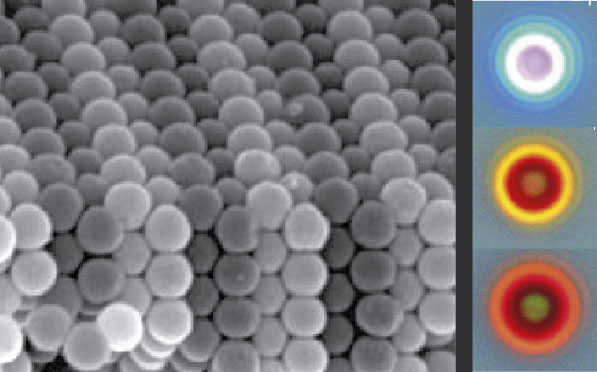
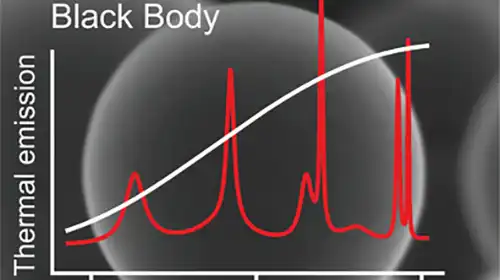
Silicon microspheres with a diameter in the range of 2–3 micrometers constitute photonic nanocavities that emit light through their Mie resonances when heated at high temperatures. At 500–600 °C these microresonators show a particular mid-infrared (MIR) emission dominated by the lowest order modes. Such resonances feature a large free spectral range, about 600 cm−1, and a high proximity to the critical coupling condition. In fact, resonances with high-quality factor, around 160 are found. It corresponds to the limit of detection of their measuring setup, being 600 the theoretical value. Most importantly, several modes emit light above the calculated black body limit because they feature an optical absorption cross-section larger than their geometric one. All these characteristics set silicon microspheres as very promising zero-dimensional materials for developing micrometric and sub-wavelength light sources in the MIR.

Supporting information with additional figures and explanations.
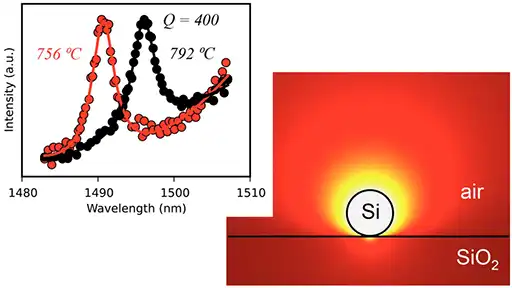
Planck’s law constitutes one of the cornerstones in physics. It explains the well-known spectrum of an ideal blackbody consisting of a smooth curve, whose peak wavelength and intensity depend on the temperature of the body. This scenario changes drastically, however,
when the size of the emitting object is comparable to the wavelength of the emitted radiation. Here we show that a silicon microsphere (2−3 μm in diameter) heated to around 800 °C yields a thermal emission spectrum consisting of pronounced peaks that are associated with Mie resonances. We experimentally demonstrate in the near-infrared the existence of modes with an ultrahigh quality factor, Q, of 400, which is substantially higher than values reported so far, and set a new benchmark in the field of thermal emission. Simulations predict that the thermal response of the microspheres is very fast, about 15 μs. Additionally, the possibility of achieving light emission above the Planck limit at some frequency ranges is envisaged.

The influence of patterned surfaces on the formation of one- and two-dimensional colloidal crystals is analyzed. We have used the corrugated surface of a digital versatile disc (DVD) for template surface processing. When the sphere diameter is on the order of the groove width of patterned substrates, a rich variety of particle decorations appear. However, if particle size is much larger than template patterns, large domains of particle ordering are formed.

This paper investigates the sequence of morphological transitions in a nearly hard particle arrangement of colloidal crystals confined in a wedge cell. Earlier studies have shown intermediate particle arrangements (such as the buckling, rhombic, prismatic, and hcp like phases) to account for the drastic changes in the filling fraction values between the triangular and square arrangements. However, to the best of our knowledge, there is no complete description of the transitions between n and n + 1 layers. Here we describe the ordering of the particles for films between 1 and 4 layers. We also present a new intermediate phase hcp(011) to show the transition between nSQUARE, nTRIANGULAR for n > 2 layers.
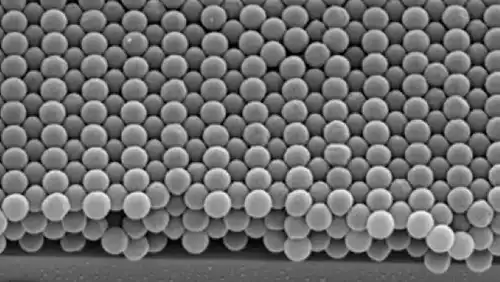
This paper investigates the sequence of morphological transitions in a nearly hard sphere arrangement confined in a wedge cell. A model that shows smooth transitions between the different particle orderings for a small number of layers is proposed. In this model, both the buckling and the [100] hexagonal close packed hcp phases are particular cases of a much more general particle arrangement tendency that we call hcp-like ordering. This phase, which does not correspond to any known close packed ordering, is able to adopt packing arrangements commensurate with the cell thickness. More striking, the hcp-like phase adapts itself to the progressive changes of the cell thickness by a smooth change in the interlayer spacing. We present hcp-like orderings up to six layers and a complete sequence of transformations between two and four layers. Finally, a packing model of the transition from two to three layers is also presented.
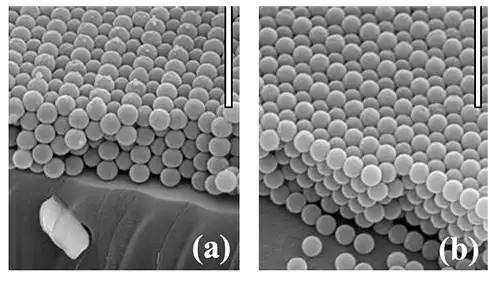
This paper investigates the sequence of morphological transitions in a nearly hard sphere arrangement confined in a wedge cell. A model that shows smooth transitions between the different particle orderings for a small number of layers is proposed. In this model, both the buckling and the [100] hexagonal close packed hcp phases are particular cases of a much more general particle arrangement tendency that we call hcp-like ordering. This phase, which does not correspond to any known close packed ordering, is able to adopt packing arrangements commensurate with the cell thickness. More striking, the hcp-like phase adapts itself to the progressive changes of the cell thickness by a smooth change in the interlayer spacing. We present hcp-like orderings up to six layers and a complete sequence of transformations between two and four layers. Finally, a packing model of the transition from two to three layers is also presented.

This paper investigates the sequence of morphological transitions in a nearly hard sphere arrangement confined in a wedge cell. A model that shows smooth transitions between the different particle orderings for a small number of layers is proposed. In this model, both the buckling and the [100] hexagonal close packed hcp phases are particular cases of a much more general particle arrangement tendency that we call hcp-like ordering. This phase, which does not correspond to any known close packed ordering, is able to adopt packing arrangements commensurate with the cell thickness. More striking, the hcp-like phase adapts itself to the progressive changes of the cell thickness by a smooth change in the interlayer spacing. We present hcp-like orderings up to six layers and a complete sequence of transformations between two and four layers. Finally, a packing model of the transition from two to three layers is also presented.